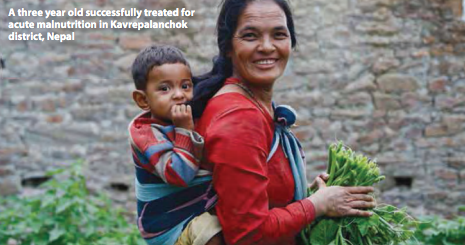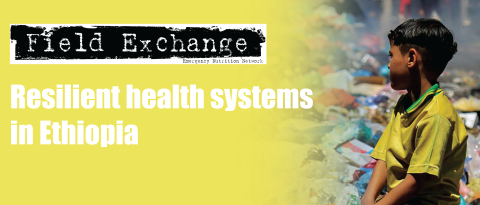Financing the sustainable scale-up of CMAM in high-burden countries
Summary of research1
Location: Global
What we know: Investment in the scale-up of community-based management of acute malnutrition (CMAM) is needed to reduce global prevalence of acute malnutrition.
What this article adds: A discussion paper examined case studies of Nepal and Kenya to provide key lessons on the scale-up of CMAM and explore sustainable financing. Progress has been made in both countries due to political and public health prioritisation by government, increased policy commitment to tackling nutrition, Ministry of Health engagement and CMAM integration into health systems, multi-sector coordination, improved financial arrangements (specific budget lines) and government ownership of costs. Financial sustainability requires domestic ownership of CMAM, lower therapeutic food costs and investment in comprehensive prevention strategies. Government and donor funding remains inadequate and must triple to achieve global wasting targets by 2025; innovative funding mechanisms are also needed to fill the current US$900 million-a-year funding gap.
Background
 In 2015, acute malnutrition threatened the lives of 50 million children under five years of age globally (UNICEF, WHO and World Bank Group, 2016). Severe acute malnutrition (SAM) is responsible for an estimated one million deaths annually (WHO, WFP, UNNSCN and UNICEF, 2007). Investment in the community-based management of severe acute malnutrition (CMAM) approach has seen treatment services spread to 80 countries and the number of children treated triple from one million in 2009 to 3.2 million in 2015 (UNICEF, 2015). Despite this, global wasting prevalence levels remain high and rapid investment and scale-up is needed to further treat and prevent acute malnutrition. Donors and governments of countries affected by high wasting rates currently spend only tiny amounts on CMAM; high costs and lack of sustainable financing are significant barriers to wider scale-up. This discussion paper examines the experiences of Nepal and Kenya, who have both made efforts to scale up CMAM, and explores the wider issues of sustainable financing of CMAM to help tackle childhood wasting by 2025.
In 2015, acute malnutrition threatened the lives of 50 million children under five years of age globally (UNICEF, WHO and World Bank Group, 2016). Severe acute malnutrition (SAM) is responsible for an estimated one million deaths annually (WHO, WFP, UNNSCN and UNICEF, 2007). Investment in the community-based management of severe acute malnutrition (CMAM) approach has seen treatment services spread to 80 countries and the number of children treated triple from one million in 2009 to 3.2 million in 2015 (UNICEF, 2015). Despite this, global wasting prevalence levels remain high and rapid investment and scale-up is needed to further treat and prevent acute malnutrition. Donors and governments of countries affected by high wasting rates currently spend only tiny amounts on CMAM; high costs and lack of sustainable financing are significant barriers to wider scale-up. This discussion paper examines the experiences of Nepal and Kenya, who have both made efforts to scale up CMAM, and explores the wider issues of sustainable financing of CMAM to help tackle childhood wasting by 2025.
Key success factors in Nepal and Kenya
Nepal has expanded from CMAM pilots in six areas with high levels of acute malnutrition in 2008 to plans to cover the 35 most affected areas by 2017. Kenya has rolled out CMAM (known in the country as integrated management of acute malnutrition (IMAM)) in badly affected areas since 2008 and is aiming for coverage across the whole country through support for a package of 11 high-impact nutrition interventions (HiNi). The authors identified the following key success factors in Nepal and Kenya:
High political and public health priority: Increased high-level political will from the Prime Minister’s office has galvanised the adoption of CMAM in Nepal. In Kenya, leadership by the First Lady and national nutrition patron has kept malnutrition high on the political agenda.
Increased policy commitment to tackling nutrition: Nepal has shown leadership in developing policy targets and commitments to tacking child wasting and nutrition in its comprehensive Multi-Sectoral Nutrition Plan (MSNP) from 2012. Kenya has developed a comprehensive National Nutrition Action Plan (NNAP), which runs until 2017.
Ministry of Health support and integration into existing health systems: Nepal’s MSNP calls for management of SAM and moderate acute malnutrition (MAM) to be fully integrated into routine health services and the Ministry of Health and Population has trained health volunteers and workers in CMAM at district and community levels. In Kenya, the Ministry of Public Health and Sanitation championed IMAM and its protocols have been integrated into Kenya’s Essential Package for Health.
Multi-sectorial coordination: Multi-sector coordination of nutrition strategies, programmes and plans has seen much progress in Nepal since the MSNP in 2012. In Kenya, coordination among stakeholders in the nutrition sector has improved since Kenya joined the Scaling Up Nutrition (SUN) Movement in 2012.
Moving towards financial sustainability: Nepal has established a budget line for MSNP and nutrition-specific interventions, which is a key step towards greater financial sustainability, although only 1.1% of its total budget was spent on nutrition in 2015 to 2016. The Government of Kenya also has a specific budget line for nutrition; however only 1.3% of its total health budget was spent on nutrition-specific interventions in 2014.
Resource mobilisation
Recent estimates suggest governments must collectively invest an additional US$70 billion over ten years to achieve the World Health Assembly (WHA) targets on stunting, anaemia and exclusive breastfeeding by 2025 and treat SAM at scale. This includes US$9.1 billion extra to treat SAM. Nutrition-sensitive allocations currently represent only about 1.7% of total government spending; it is recommended that domestic governments should commit at least 3% of relevant budgets for nutrition. Financial sustainability lies in taking greater domestic ownership of CMAM, driving down ready-to-use therapeutic food (RUTF) costs and making sustained investments in prevention strategies.
An analysis of official development assistance (ODA) from the European Union (EU), UK and US for interventions relating to acute malnutrition between 2010 and 2014 showed that they gave just US$270 million to 362 projects during this period. The EU supported the most projects relating to acute malnutrition (171), although most of these were funded via emergency or humanitarian funds. The US supported 161 interventions, while the UK supported 30 projects. Innovative finance could contribute an additional US$3.4 billion over ten years; promising initiatives include UNITAID, UNITLIFE, The Power of Nutrition and The Global Financing Facility in Support of Every Woman Every Child, among others.
Governments of affected countries and donors currently spend tiny amounts on nutrition-specific interventions and overall the World Bank say a 3.5-fold increase is required to close the funding gap by 2025. The authors make several recommendations to governments and donors (Box 1) to help support the process of scale-up.
Box 1: Recommendations
All high-burden countries:
- Establish specific nutrition budget lines and increase national budget allocations to enable nationwide CMAM scale-up.
- Target at least 3% of relevant national budget towards tackling nutrition.
- Invest in strengthening health systems and include nutrition as part of a basic health package.
Kenya:
- Intensify financial commitment for nationwide CMAM scale-up through HiNi.
Nepal:
- Revitalise parliamentary, cabinet and high-level nutrition and food security committees to deepen national ownership of the MSNP.
All donors:
- Triple financial commitment to nutrition over ten years and increase multi-year funding for CMAM scale-up.
- Redirect support for CMAM scale-up towards countries with high wasting burdens.
- Improve quality of reporting to increase transparency and better track CMAM.
- Invest in health systems strengthening and the inclusion of nutrition treatment of SAM within a basic healthcare package of services.
EU:
- Develop a specific target to treat and prevent wasting in children under five years old in development contexts by 2025.
- Pledge an additional €1 billion for multi-year, nutrition-specific interventions, including CMAM, by 2020.
- Ensure humanitarian support for CMAM interventions is multi-year and fully integrated with wider development objectives.
EU & US:
- Improve the level of detail available in the ‘long descriptions’ of nutrition/acute malnutrition projects on the creditor reporting system (CRS).
Footnotes
1Wijeratna A. (2017). Financing the sustainable scale-up of CMAM in high-burden countries with case studies from Nepal and Kenya. Discussion paper, March 2017. Action Against Hunger, International Medical Corps and Global Health Advocates.
References
UNICEF, WHO and World Bank Group (2016) Levels and trends in child malnutrition: UNICEF, WHO, World Bank Group joint estimates: Key findings of the 2016 edition. Available from: www.who.int/nutgrowthdb/jme_brochure2016.pdf
UNICEF (2015) Annual results report: Nutrition. Available from: www.unicef.org/publicpartnerships/files/2015ARR_Nutrition.pdf
WHP, WFP, UNSCN and UNICEF (2007). Community-based management of severe acute malnutrition Joint statement. Available from: www.who.int/nutrition/topics/statement_commbased_malnutrition/en/


